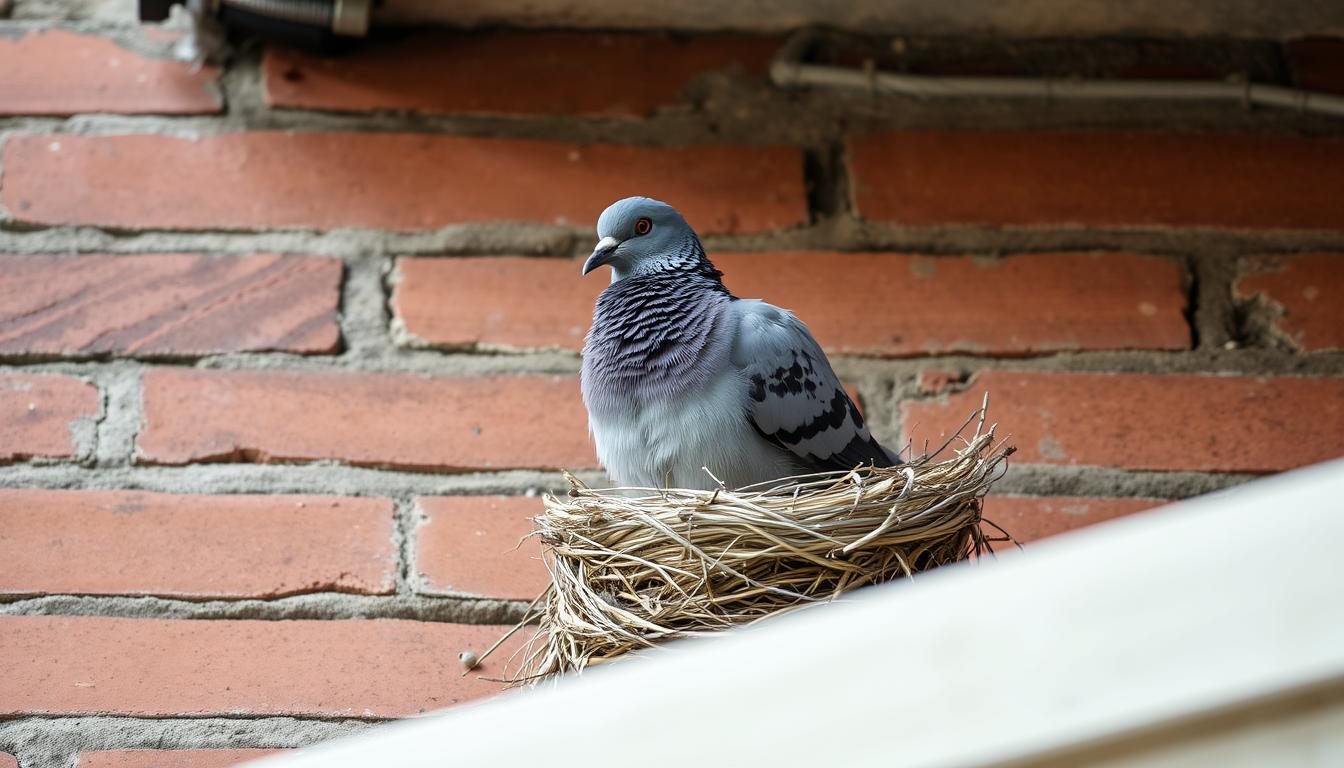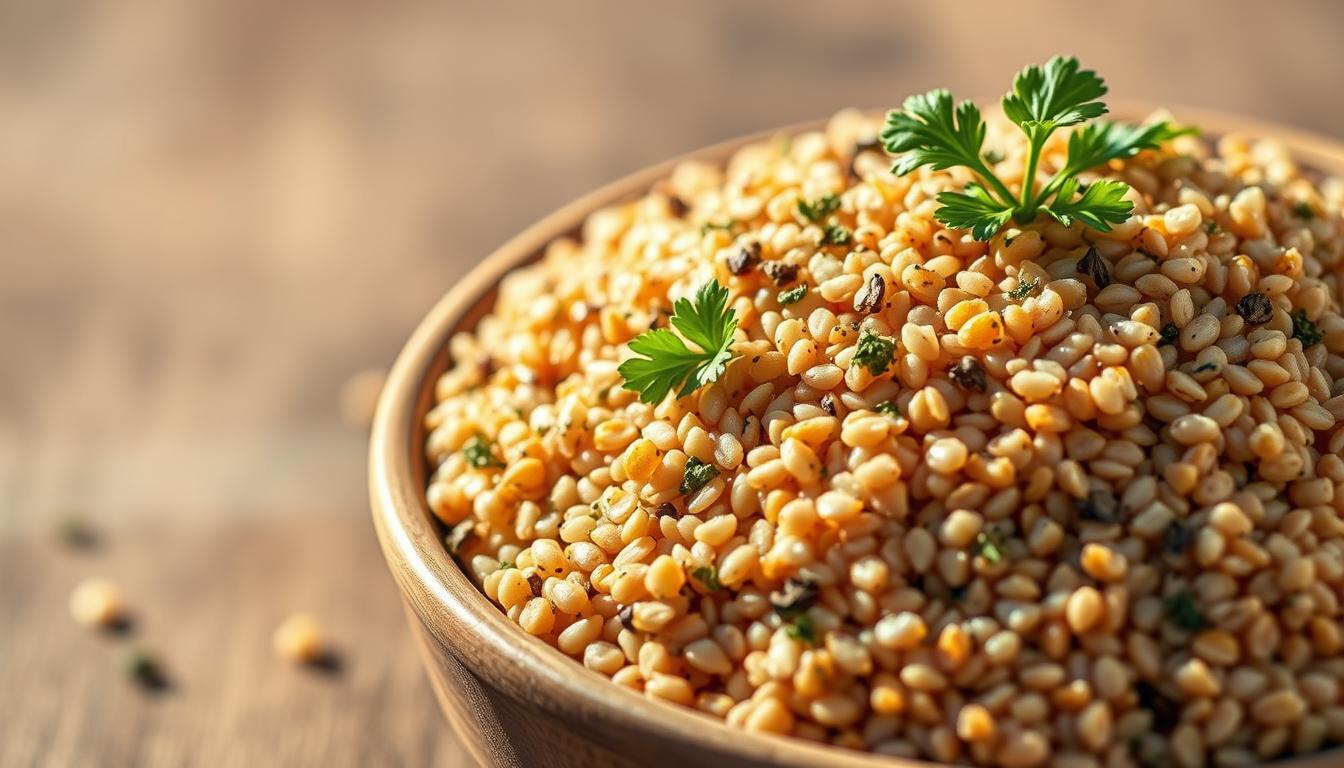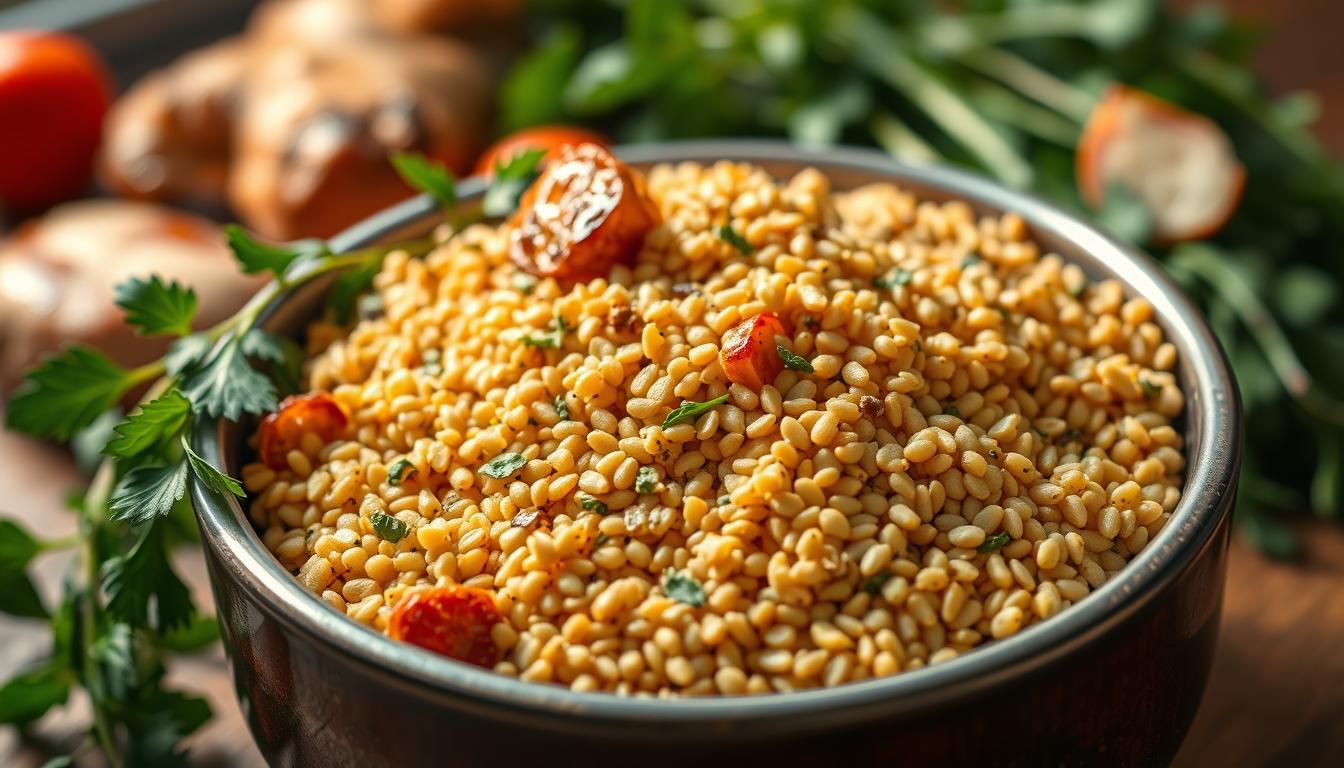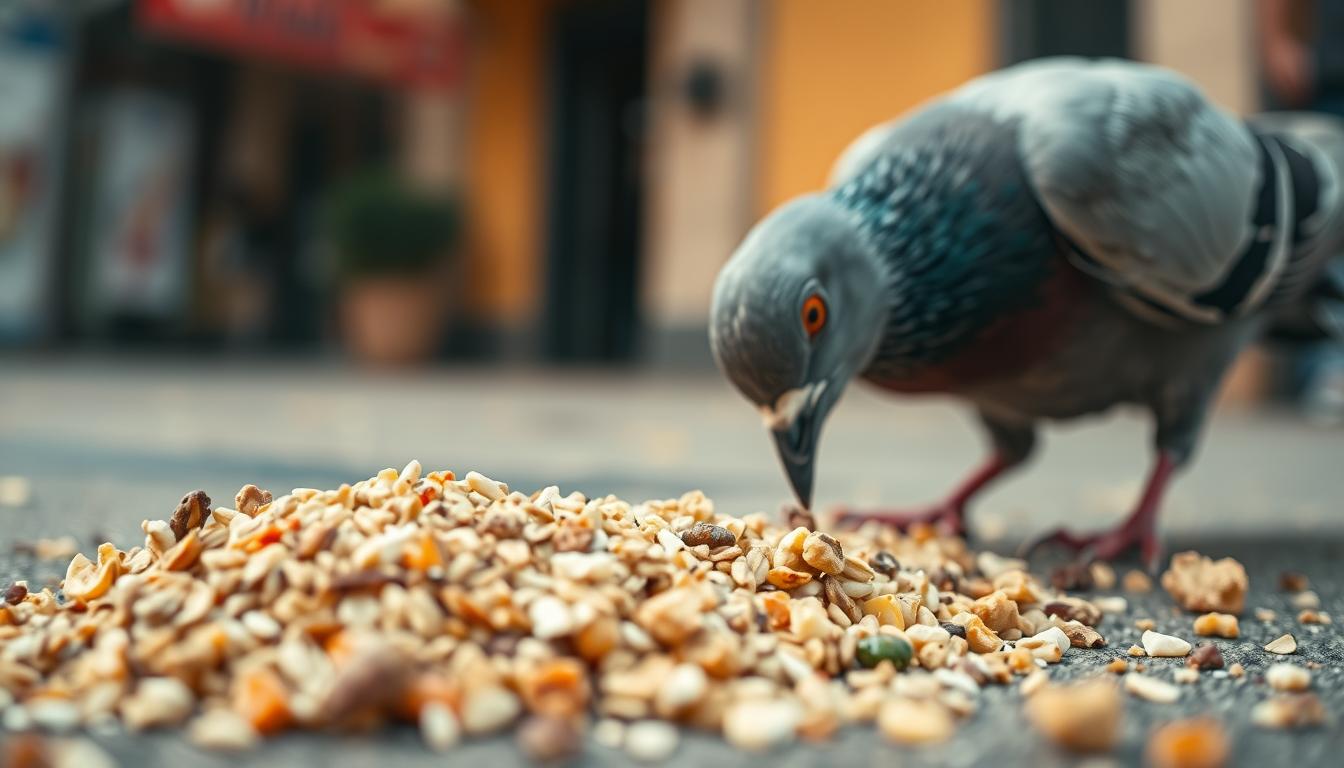Every day, urban wildlife battles silently, unseen by many. Pigeons, often ignored, fight to survive and raise their young. With nearly 400 million pigeons worldwide, they are key to our urban ecosystems.
Your backyard, neighborhood, or city street might hide dangers for a pigeon on nest. City birds show amazing adaptability but face many risks. These risks can harm their nesting places.
Understanding urban wildlife means seeing the big challenges pigeons face. They deal with predators, habitat loss, and more. These smart birds try to care for their young in a tough world.
In this important look, we’ll reveal the five biggest dangers to pigeons. We’ll also share ways to help protect these urban survivors. Your help can really make a difference for these resilient birds.
Table of Contents
Understanding the Importance of Pigeons in Urban Ecosystems
Urban areas have become homes for pigeons, making them key parts of city life. With about 400 million pigeons globally, they are vital in urban wildlife.
Pigeons are amazing at living in cities. They show how well they can adapt to different city environments. This shows their big role in city ecosystems:
- Seed dispersal through their eating habits
- Natural waste management in urban areas
- Indicators of environmental health
- Supporting local food chains
The Role of Urban Pigeons
A pigeon on nest is more than just a bird. It’s a key player in urban ecosystems. These birds use man-made places like rooftops and balconies as homes. Female pigeons can lay up to 12 eggs a year.
Benefits to Urban Biodiversity
Experts see pigeons as important for city biodiversity. They help keep the ecosystem balanced by:
- Eating urban food waste
- Being food for predators like Peregrine Falcons
- Helping keep bird populations diverse
Learning about and protecting pigeons helps make cities healthier and more balanced.
Common Threats Facing Pigeons on Nest
Pigeons have many challenges during their nesting time. This makes their care a delicate and risky task. Knowing these threats helps protect these urban birds and their young.
Urban areas pose many dangers to pigeons on nest. These dangers can affect their survival and ability to have babies. Threats come from predators, human actions, and environmental dangers.
Predation Risks
Pigeon nests are at risk from many predators. These predators can harm eggs and young birds. Some of the main predators are:
- Domestic cats
- Peregrine falcons
- Corvids
- Rats and raccoons
- Owls and raptors
Human Interference
Urban growth is a big challenge for pigeons during nesting. Human threats include:
- Nest removals
- Construction disruptions
- Lack of safe nesting places
Environmental Hazards
Pigeons face big environmental challenges. These challenges include:
- Pesticide exposure
- Air pollution
- Extreme weather
- Not enough food
By understanding these threats, we can help protect pigeons in cities. This supports their important role in urban ecosystems.
How Urbanization Impacts Pigeon Nesting
Urban wildlife faces big challenges as cities grow. Pigeons, known for living in cities, find their homes changing fast. This is because of quick urban growth.
City birds like pigeons have changed how they live because of cities. The old natural places are now concrete. This makes it hard for pigeons to raise their young and survive.
Loss of Natural Habitat
Urban growth has cut down pigeon homes. Research shows important points:
- Urban areas have 99% physical structures compared to rural landscapes
- Population density in urban zones exceeds 1000 individuals/km²
- Bird species richness drops significantly in urban settlements
Increase in Heat and Pollution
The city life adds more stress for pigeons:
- Increased temperature in urban heat islands
- Higher levels of anthropogenic noise
- Reduced vegetation cover
But pigeons are very adaptable. Urban wildlife continues to evolve. They find new ways to nest in our changing cities.
Identifying Signs of Distress in Pigeon Nests
Watching over a pigeon nest is crucial. Mothers send out signals when they’re stressed. Learning these signs helps protect these birds in cities.
Vocalizations and Behavior Indicators
Pigeons show distress in unique ways. Keep an eye out for these signs:
- Rapid, sharp cooing sounds indicating immediate threat
- Unusual wing fluttering or aggressive posturing
- Repeated head movements scanning the surrounding area
- Abandonment of nest building instincts
Physical Signs of Threat
Physical signs can warn of danger to pigeons. Look for these indicators:
- Visible damage to nest structure
- Feathers appearing ruffled or stressed
- Unusual stillness or lack of movement
- Evidence of predator proximity
Spotting these signs early helps protect pigeons. Your help can greatly improve their chances of survival.
The Dangers of Predators to Pigeons on Nest
Urban wildlife faces many challenges, and pigeons are especially at risk. Knowing the dangers to pigeons on nest helps protect these amazing birds in cities.
Many predators in cities threaten nesting pigeons. These dangers can harm young squabs and adult birds a lot.
Common Urban Predators
- Hawks and falcons hunting from rooftops
- Feral cats prowling around nesting sites
- Rats targeting eggs and young chicks
- Aggressive larger bird species
Protecting Nesting Sites
To keep urban wildlife safe, you can take a few steps:
- Create visual barriers around nesting areas
- Remove potential predator hiding spots
- Install deterrent devices that don’t harm birds
- Maintain clean surrounding environments
Pigeons are tough winged nurturers, but they need our help in cities. By knowing their risks, we can protect these vital urban wildlife members.
Human Activities That Endanger Pigeons
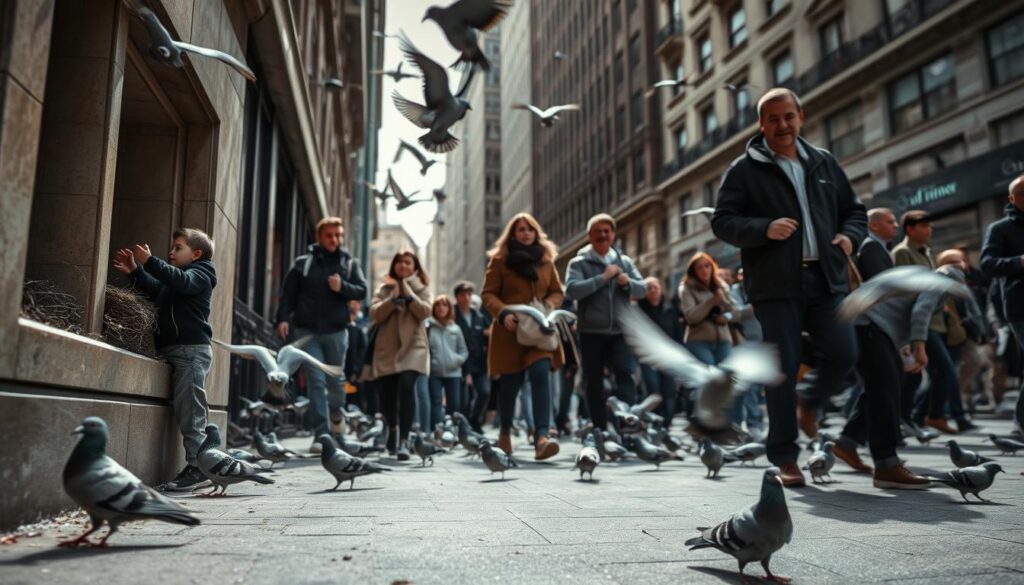
Urban areas pose big challenges for pigeons. Your actions might harm pigeons without you knowing. It’s key to understand how we affect these birds for their survival.
Construction and Nest Displacement
Urban growth harms pigeon homes. Building projects destroy nests, making birds leave their babies. This hurts pigeon breeding a lot.
- Remove nesting materials during non-breeding seasons
- Use humane deterrent methods
- Consult wildlife experts before major construction
Problematic Feeding Practices
Feeding pigeons can be a problem. The wrong food can make them dependent and change their behavior.
- Avoid bread and processed foods
- Provide balanced, nutritious seeds
- Maintain clean feeding areas
Managing urban wildlife well means knowing and respecting pigeon homes. By choosing wisely, you can protect these amazing city birds.
Protecting Pigeons: Essential Strategies for Homeowners
Homeowners need to protect urban wildlife, especially pigeons. Making safe spaces for bird nesting requires careful planning. It also needs thoughtful approaches to managing urban habitats.
Knowing how pigeons build nests helps you create better spaces for them. They look for safe spots that protect them from predators and harsh weather.
Creating Safe Nesting Spaces
Here are some ways to help urban pigeons:
- Install smooth ledges with slight overhangs
- Provide sheltered areas away from direct sunlight
- Use bird-friendly materials like wood or stone
- Ensure nesting areas have minimal human disturbance
Avoiding Chemical Hazards
It’s important to keep harmful chemicals away from pigeons. Chemical pesticides can harm bird populations and upset urban ecosystems.
- Replace toxic pesticides with natural alternatives
- Use essential oils like peppermint and lavender as deterrents
- Clean outdoor areas regularly to prevent pest attraction
- Choose eco-friendly gardening practices
By following these tips, you can make a safe space for urban wildlife. This way, you can also keep your outdoor area clean and healthy.
Legal Protections for Pigeons and Their Nests
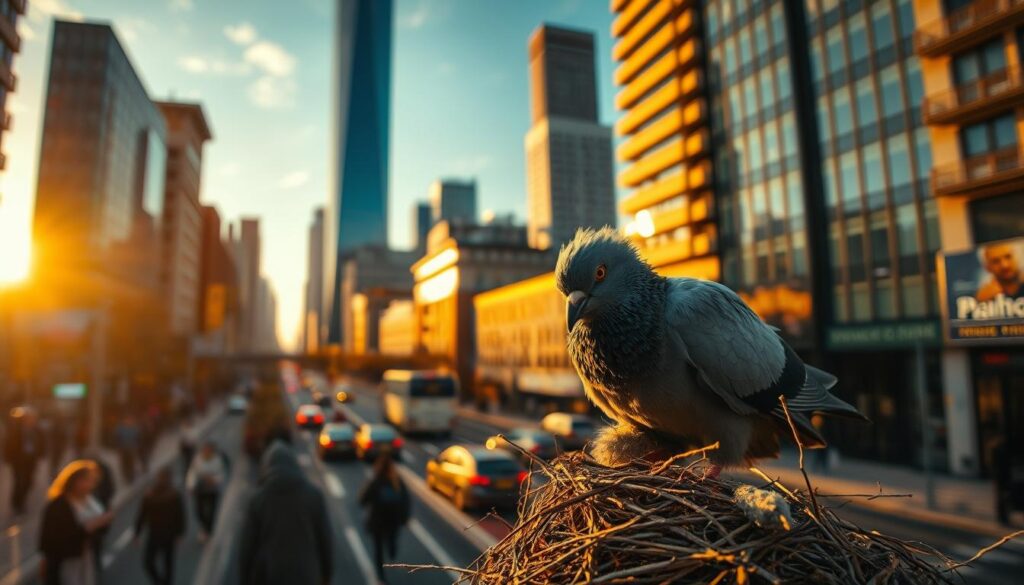
Protecting urban wildlife, like pigeons on nest, means knowing about complex laws. These laws help keep bird habitats safe. The United States has made laws to protect birds in different places.
Wildlife protection laws are very important for pigeons in cities. Key legal protections include:
- Federal Migratory Bird Treaty Act protecting many bird species
- State-specific wildlife conservation laws
- Rules against destroying active bird nests
Understanding Wildlife Protection Laws
California has strong laws to protect birds. The state’s Fish and Game Code makes it illegal to harm bird nests or eggs. It also has rules for penalties if you harm bird habitats, especially for protected species.
How You Can Advocate for Pigeons
You can help protect urban wildlife. Here are some ways to help:
- Reach out to local wildlife groups
- Support laws that protect bird homes
- Teach others about pigeon conservation
- Tell local authorities about illegal nest harm
By supporting these laws, you help keep urban bird populations safe.
Best Practices for Observing Pigeons without Disturbing Them
Urban areas are home to fascinating birds that deserve our respect. City bird behavior shows complex social interactions, especially when pigeons nest. It’s important to know how to interact with these birds carefully.
Watching pigeons on their nests can be amazing. But, it’s key to not stress them out. Your interest should never put their safety or natural actions at risk.
Maintaining Safe Distances
Here are important tips for watching pigeons:
- Keep at least 15-20 feet away from nests
- Use binoculars or zoom lenses for closer looks
- Avoid sudden moves that might scare birds
- Never try to touch or get close to nests
Minimizing Noise Pollution
Urban areas can be tough for nesting birds. Your actions can help reduce their stress:
- Speak softly and calmly near nests
- Turn off electronic devices
- Move slowly and in a predictable way
- Limit how long you watch them
By following these tips, you become a responsible bird watcher. You help protect the city’s bird ecosystem while enjoying these amazing birds.
Community Efforts to Support Urban Pigeons
Passionate bird lovers across the United States are working hard to protect urban wildlife. They focus on feral pigeon breeding, seeing their important role in the ecosystem.
Palomacy is a great example of community support. Since 2007, they’ve helped over 2,000 pigeons find new homes. This is a big step in protecting urban wildlife.
Local Organizations Making a Difference
Community efforts for urban pigeons are growing everywhere. These groups help pigeons and their babies, facing city challenges together.
- Rescue and rehabilitation of injured pigeons
- Creating safe nesting spaces
- Educational programs about urban bird conservation
- Volunteer opportunities for bird enthusiasts
How You Can Get Involved
You can help make a difference for urban pigeons. Here are some ways to get involved:
- Volunteer with local wildlife rescue organizations
- Donate to pigeon conservation efforts
- Participate in citizen science bird monitoring projects
- Learn about responsible urban wildlife interactions
By joining these efforts, you play a key role in protecting urban pigeons. You help us understand and care for their world.
Conclusion: Your Role in Pigeon Conservation
Urban wildlife, like pigeons on nest, need our help and understanding. Your actions can make a big difference for these amazing city birds. By learning about their behavior and needs, you become a key protector of urban diversity.
The story of the passenger pigeon is a strong reminder of species loss. These birds, once 3 billion to 5 billion strong, vanished in 40 years. This shows how crucial conservation efforts are for today’s urban birds.
The Impact of Individual Actions
Protecting a pigeon on nest or making urban spaces safe is vital. Small actions, like reducing chemicals and keeping quiet near nests, help a lot. They can save wildlife.
Inspiring Others to Protect Urban Wildlife
Your dedication to pigeon conservation can motivate others to care for urban wildlife. By sharing what you know, pushing for policies, and showing respect for these birds, you help create a better city. Every informed action helps keep our city ecosystems balanced.
FAQ
Why are pigeons important in urban ecosystems?
Pigeons are key in cities because they help spread seeds and show us how healthy the environment is. They also keep the balance in urban areas. These birds have made cities their home, offering important services.
What are the main threats to pigeons nesting in cities?
Pigeons face dangers like being eaten by cats and birds of prey. Humans also harm them with construction and pollution. They lose places to nest because of urban growth and less green areas.
How can I tell if a pigeon nest is in distress?
Look for signs like loud noises, birds acting strangely, and empty nests. You might see damaged nests or birds coming and going fast. Physical signs include exposed eggs and nest damage.
Are pigeons protected by law?
Not all pigeon species are fully protected by law. But, some laws in the U.S. help. Local and state rules might also protect native birds.
How can homeowners create safe spaces for nesting pigeons?
You can help pigeons by putting up ledges or nest boxes. Avoid using harmful chemicals and keep green spaces. Make sure there are safe areas away from predators.
What predators do urban pigeons face?
Pigeons in cities are threatened by cats, rats, hawks, and falcons. Sometimes, raccoons also pose a risk. These predators can harm adult pigeons and their young.
How do human activities impact pigeon nesting?
Human actions like construction and feeding pigeons the wrong way can harm them. Chemicals and making cities less green also hurt pigeon nesting sites.
Can I help protect urban pigeons?
Yes! You can help by supporting conservation, creating safe nesting spots, and avoiding harmful chemicals. Educate others, join citizen science projects, and think about pigeon habitats in urban planning.
How should I observe pigeons without disturbing them?
Keep a safe distance and avoid loud noises. Move slowly and quietly. Use binoculars for a closer look. Never touch or interact with nesting pigeons or their young.
What community efforts exist to support urban pigeons?
Local groups, urban ecology organizations, and bird protection networks help pigeons. They do research, preserve habitats, educate the public, and advocate for bird-friendly cities.
Source Links
- Fascinating Facts About Pigeons & How to Handle Pigeon Problems – https://www.excelpestservices.com/11-fun-facts-about-pigeons/
- Pigeon-proofing – https://protonsforbreakfast.wordpress.com/2024/11/15/pigeon-proofing/
- Fascinating Pigeon Facts and Figures: 2024 Insights – https://www.ovocontrol.com/pigeon-facts-figures?srsltid=AfmBOoqTWYc02kP9XhyKtm2Vwfu9ER-oOQTl39Pf0SglOcCjUC7jPM5y
- How City Birds Are Adapting to Urban Life in Surprising Ways – BirdWatching – https://www.birdwatchingdaily.com/beginners/birding-faq/how-city-birds-are-adapting-to-urban-life-in-surprising-ways/
- Fascinating Pigeon Facts and Figures: 2024 Insights – https://www.ovocontrol.com/pigeon-facts-figures?srsltid=AfmBOorTeXld0ENPyMJp6bs2MmBDyRHnZcqdCXJQUSYd10GTEZA92Gk0
- Pigeon Nesting Habits and Behavior: An In-depth Look – https://birdfact.com/articles/pigeon-nesting
- What to do about pigeons – https://www.humaneworld.org/en/resources/what-do-about-pigeons
- I Found a Pigeon Nest. What Do I Do? – https://www.hawkeye.ca/blog/i-found-a-pigeon-nest-what-do-i-do
- Frontiers | Structural and acoustic properties of urbanized landscapes adversely affect bird communities in a tropical environment – https://www.frontiersin.org/journals/ecology-and-evolution/articles/10.3389/fevo.2024.1457049/full
- Long-Term Changes in Bird Communities in the Urban Parks of Mar del Plata City, Argentina – https://www.mdpi.com/2673-6004/5/4/54
- Frontiers | Long-term directional changes in urban bird communities of Mar del Plata City, Argentina – https://www.frontiersin.org/journals/ecology-and-evolution/articles/10.3389/fevo.2024.1457476/full
- Column: Know what to do if you find a baby bird or other wildlife in distress – https://www.pasadenastarnews.com/2024/03/22/column-know-what-to-do-if-you-find-a-baby-bird-or-other-wildlife-in-distress/
- Pigeon menace: A health hazard thriving in plain sight – https://www.indiatoday.in/health/story/pigeons-menace-dropping-feathers-health-hazard-lung-diseases-2606803-2024-09-26
- Pigeon Control Services I Pigeon Solutions – https://www.solidaviansolutions.com/pigeon-control-services.html
- The Secret Life of the Baby Pigeon – https://www.hawkeye.ca/blog/baby-pigeon
- Solving Problems with Pigeons – https://www.helpwildlife.co.uk/advice/problem-pigeons/
- Fascinating Pigeon Facts and Figures: 2024 Insights – https://www.ovocontrol.com/pigeon-facts-figures?srsltid=AfmBOoqOM6LtAdRylaUVcG8YVxkexOMzQGz7WHsfrAX_iFrXrXoLHv7S
- How to Keep Pigeons Away – Today’s Homeowner – https://todayshomeowner.com/pest-control/guides/how-to-keep-pigeons-away/
- How to Remove Pigeons From Your Residential Roof – https://www.hawkeye.ca/blog/how-to-remove-pigeons-from-your-residential-roof
- CA – Birds – Part 2. Birds. – https://www.animallaw.info/statute/ca-birds-part-2-birds
- Migratory Bird Permits | U.S. Fish & Wildlife Service – https://www.fws.gov/program/migratory-bird-permits
- What Should I do When a Bird Nests Near my House? – https://www.skedaddlewildlife.com/location/montreal/blog/what-should-i-do-when-a-bird-nests-near-my-house/
- Ethogram of the Pigeon – Great Lakes Pigeon Rescue – https://greatlakespigeonrescue.org/ethogram-of-the-pigeon/
- How To Stop Birds From Nesting Around Your Home – https://www.familyhandyman.com/article/how-to-stop-birds-from-nesting-around-your-home/?srsltid=AfmBOopaLZQhdGMLTjWNBAxlCNaWB3UPTyHPTlaoFs0VJKKhaQpjbTsT
- Palomacy Pigeon & Dove Adoptions – https://www.pigeonrescue.org/
- Why You Should Appreciate Pigeons. Yes, Pigeons. – https://www.massaudubon.org/news/latest/why-you-should-appreciate-pigeons
- Project Passenger Pigeon – https://naturemuseum.org/cas/project-passenger-pigeon
- How Pigeons Find Their Home? The Secrets Behind Their Incredible Homing Ability – https://www.birdfy.com/blogs/blogs/how-pigeons-find-their-home-the-secrets-behind-their-incredible-homing-ability?srsltid=AfmBOoplVpaglmUhlJJyqNEGyHMg8GLRekfMAkBR1ZDUKrb1knli5EXf

